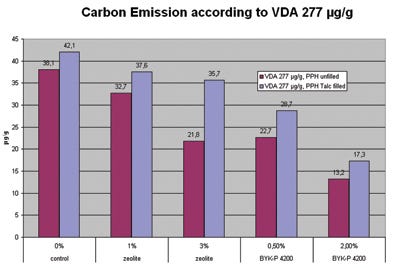New additive concept enables an effective reduction of odor and VOC
Emissions and volatile organic compounds (VOCs) can arise during processing of plastics, and also evaporate out of the finished product—the famous "new-car smell" that automotive OEMs work so hard to avoid. Plastics suppliers and suppliers of recycled plastics often try to reduce emissions by means of processing agents or additives that adsorb the VOCs. Although the VOCs are bound, they are still contained within the plastic and could be released under certain conditions, often exacerbated by heat and sunlight or by processing parameters such as temperatures and dwell times.
September 21, 2009
Emissions and volatile organic compounds (VOCs) can arise during processing of plastics, and also evaporate out of the finished product—the famous "new-car smell" that automotive OEMs work so hard to avoid. Plastics suppliers and suppliers of recycled plastics often try to reduce emissions by means of processing agents or additives that adsorb the VOCs. Although the VOCs are bound, they are still contained within the plastic and could be released under certain conditions, often exacerbated by heat and sunlight or by processing parameters such as temperatures and dwell times.
A new additive concept from BYK-Chemie claims to allow for compounding with considerably reduced quantities of undesirable VOCs and odors. The additive works much like a stripping agent. Its molecular structure is designed so that during compounding it is active on the surface of the granulate in the melt so that the VOCs are almost completely separated from the granulate. The resulting mixture of VOCs and additive carrier substance is then removed as a vapor by degassing during compounding. Current standard practice is to use microporous materials to adsorb VOCs and odors.
|
According to BYK-Chemie’s Jörg Garlinsky, who heads its technical service group in the plastics additives division, the disadvantage of many adsorbents, such as activated carbon or zeolites (aluminosilicates), is that the VOCs or odors are physically bound to their surface. These volatiles may be freed eventually, particularly in summer when the temperature inside a car may exceed 70°C. Although adsorbents may delay the release of bound substances, they cannot prevent it entirely. Plus, adsorbents may have an adverse effect on the mechanical properties of a compound, he says.
Also used are stripping agents, such as water, nitrogen or carbon dioxide, which are added directly into the melt during extrusion. The undesirable odors and VOCs can then be stripped out during extrusion by a degassing system, preferably using a vacuum. The downside of this method is the more complex engineering and the additional investments for the associated machinery.
BYK’s answer is BYK-P 4200, supplied as a granulate with a polypropylene carrier. It can be added to extrusion similar to a masterbatch via the main feeder or a side feeder. It works in two steps. In the first processing step, the active substance is released into the melt by shear force and heat. The pressure buildup during processing prevents premature expansion of the stripping additive.
In the second step, the stripping additive evaporates in the vacuum degassing zone, leading to greater foaming of the polymer melt. The resulting gas bubbles have a large inner surface area. This process is promoted and intensified by the surfactant additive contained in the aqueous active substance of the stripping agent. The stripping agent reduces the solubility of the volatile constituents, which are then extracted during degassing. It has been shown to function for both unfilled and talc-filled compounds. —[email protected]
About the Author(s)
You May Also Like



